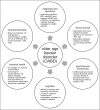Older age bipolar disorder
- PMID: 37458495
- PMCID: PMC10399956
- DOI: 10.1097/YCO.0000000000000883
Older age bipolar disorder
Abstract
Purpose of review: Older age bipolar disorder (OABD) refers to patients with bipolar disorder aged 50 years and over. There is a paucity of evidence-based guidelines specific to OABD, but in recent years, several studies have been published on OABD. The current review synthesizes previous literature (up to January 1, 2021) as well as most recent literature on OABD (since January 1, 2021).
Recent findings: This review covers the following themes: diagnosis and specifiers, clinical course, psychosocial functioning, cognition, physical comorbidities, and pharmacotherapy. On the basis of the latest data, specific clinical recommendations are proposed for each theme.
Summary: OABD forms a more complex subgroup of bipolar disorder, with an increased risk of cognitive deficits, physical comorbidities, impaired psychosocial functioning, and premature death. The distinctions between BD-I and BD-II and between EOBD and LOBD do not clinically represent relevant subtypes for OABD patients. Mental healthcare professionals should treat all OABD patients with an integrative care model that takes into account cognitive and physical comorbidities and that contains elements aimed at improvement of psychosocial functioning and quality of life. Older age itself should not be a reason to withhold lithium treatment. Future research should collect data on essential data domains using validated measurement scales.
Copyright © 2023 The Author(s). Published by Wolters Kluwer Health, Inc.
Conflict of interest statement
Figures
References
-
- Kessing LV, Vradi E, McIntyre RS, Andersen PK. Causes of decreased life expectancy over the life span in bipolar disorder. J Affect Disord 2015; 180:142–147. - PubMed
-
- Rizzo LB, Costa LG, Mansur RB, et al. . The theory of bipolar disorder as an illness of accelerated aging: implications for clinical care and research. Neurosci Biobehav Rev 2014; 42:157–169. - PubMed
-
- Schouws SN, Comijs HC, Dols A, et al. . Five-year follow-up of cognitive impairment in older adults with bipolar disorder. Bipolar Disord 2016; 18:148–154. - PubMed
-
- Samame C, Martino DJ, Strejilevich SA. A quantitative review of neurocognition in euthymic late-life bipolar disorder. Bipolar Disord 2013; 15:633–644. - PubMed
Publication types
MeSH terms
LinkOut - more resources
Full Text Sources
Medical
Research Materials



